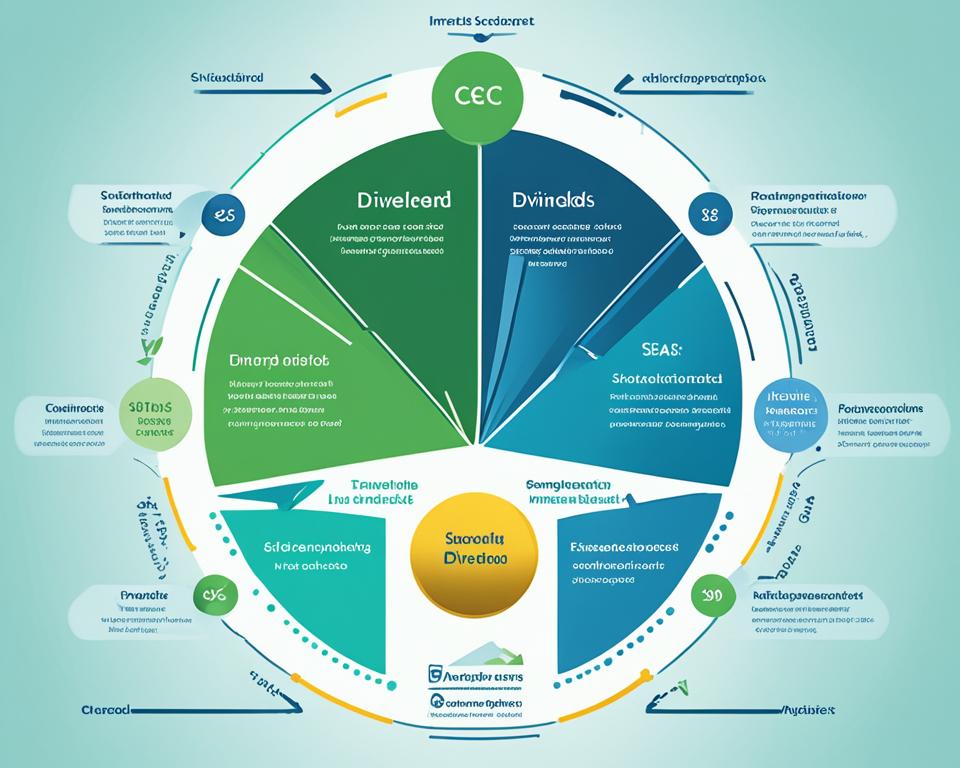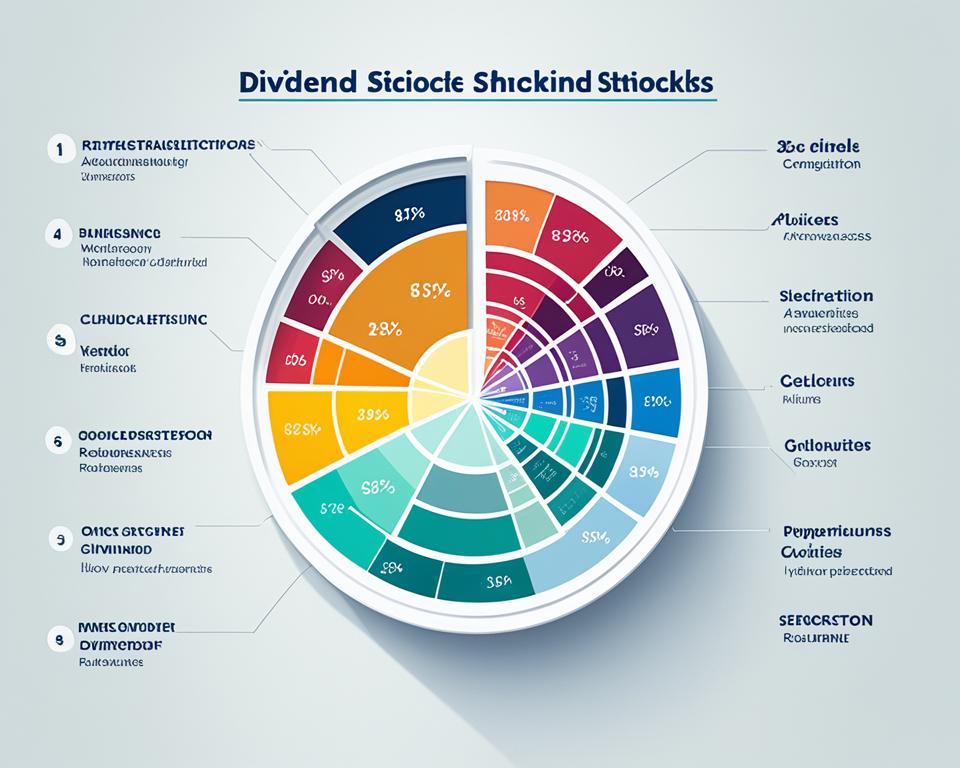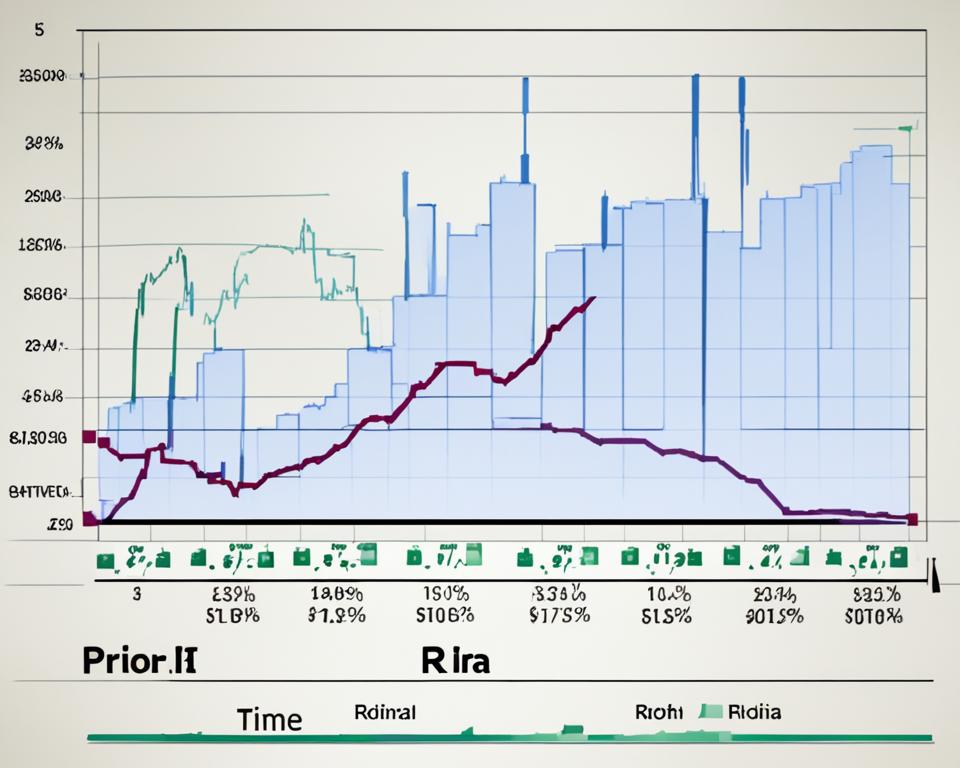Investors in today’s dynamic market may find exciting opportunities in creating a diversified portfolio of dividend stocks. Diversification, a critical strategy in investment, reduces reliance on any single security and protects one’s capital from abrupt market shifts by spreading the risk across numerous stocks. It is particularly significant when it comes to dividend investing, where the goal is to generate a stable income stream.
Maintaining a right balance in your portfolio involves a thoughtful mix of stocks across various sectors and picking companies known for their consistent dividend payouts. Failing to follow diverse strategies, investors can find themselves subjected to extreme losses. A notable example is the 2001 Enron scandal which saw the energy giant’s stocks collapse overnight, leading to immense losses for investors who had over-concentrated their portfolios. Naturally, the driving goal is to design a stock portfolio that yields consistent dividends yet withstands market volatility.
This article will provide actionable guidance on establishing a robust, diversified dividend stock portfolio that suits your financial goals and risk tolerance.
Key Takeaways
- Investment diversification is essential to reduce risk and prevent over-reliance on a single stock.
- A diversified portfolio of dividend stocks provides a reliable income source and insulates against market shifts.
- A balanced portfolio consists of a diverse range of stocks across multiple sectors.
- Opt for companies with a stable history of dividend payouts to ensure consistent income.
- Consider historical examples like Enron to understand the dangers of portfolio over-concentration.
- The goal of dividend investing is balance – generating steady returns while safeguarding against market volatility.
Understanding the Importance of Diversification
When building a diversified investment portfolio, one crucial consideration is the management of investment risk through the tool of diversification. Diversification encapsulates the classic investing adage of not putting all eggs in one basket, and aids in cushioning the impact of specific company downturns and changes in market trend.
The significance of diversification is particularly underscored when contemplating investment in dividend stocks. This strategy, often known as dividend stock diversification, is foundational to a solid investment approach.
The Role of Diversification in Managing Risk
The inherent unpredictability and fluctuating nature of investment outcomes necessitates a diverse approach of investment to limit over-reliance on a single stock. By investing in a wide array of stocks, one is better equipped to weather the storm of potential setbacks and market fluctuations without sustaining significant capital loss.
Historical Perspectives on Portfolio Diversification
Reviewing historical market performance demonstrates the ability of widespread diversification to maintain a balance even in times of unanticipated market changes. This mitigates the risk of substantial losses, emphasizing the importance of effective portfolio diversification for achieving resilient investment outcomes over time.
Lessons from Market Anomalies like Enron and Lehman Brothers
One need not look beyond the catastrophic collapses of Enron and Lehman Brothers to understand the perils of over-investment in single stock options. These illustrations of market anomalies underscore the importance of diversification as a paramount strategy in safeguarding one’s capital investments.
A diversified portfolio is comprised of various asset types, often referred to as asset allocation. The following table details three potential asset allocation models that an investor could use to build a diversified portfolio.
| Conservative Portfolio | Moderate Portfolio | Aggressive Portfolio |
|---|---|---|
| 50% bonds | 45% stocks | 70% stocks |
| 40% stocks | 45% bonds | 20% bonds |
| 10% cash | 10% cash | 10% cash |
Each of these models features a different approach to risk management. A conservative portfolio generally includes a large portion of bonds, which are designed to maintain capital and generate income. A moderate portfolio balances the requirements of capital growth and income. An aggressive portfolio, on the other hand, prioritizes capital growth over income.
Fundamentals of Dividend Investing
The attraction of dividend investing lies primarily in the potential for generating a steady flow of income. For the investors aiming for this kind of financial independence, understanding the fundamentals of dividend yields is essential. At its core, dividend investing is about selecting dividend-paying stocks – this is the dividend stock selection process.
Companies that consistently share profits with their shareholders typically pay out dividends, usually in the form of cash or additional shares. The decision to dole out dividends depends on a company’s financial policies and performance. Sometimes, companies might even distribute dividends during non-profitable periods to maintain their payout history. Dividends play a significant role in providing investors with consistent income through dividends.
Dividends can be classified into regular dividends and special dividends. Regular dividends are distributed at set intervals, typically quarterly, semi-annually, or annually. On the other hand, special dividends are one-time rewards reflecting particular milestones or significant earnings surges.
| Type of Dividend | Description | Benefits |
|---|---|---|
| Regular Dividend | Dividends that are paid out at a regular interval (quarterly, semi-annually, or annually). | Provides a predictable and steady income stream for investors. |
| Special Dividend | A one-time dividend payment reflecting particular milestones or earnings surges. | Can offer a substantial one-off return on investment. |
These aspects of dividend investing underscore the importance of understanding and employing savvy dividend investing strategies. A well-planned strategy may significantly augment an investor’s income over time, securing financial stability.
Strategies for Selecting Dividend-Paying Stocks
Investing in dividend-paying stocks can create a consistent income stream. However, the task of choosing the right dividend stocks can be complex, requiring a prudent approach and sturdy strategies. Factors such as Dividend Safety Scores, regular and special dividends, and dividend yield risks can play crucial roles in this process. Let’s delve deeper into these aspects.

Assessing Dividend Safety Scores
Dividend Safety Scores are a robust tool in dividend stock selection strategies. They help investors gauge the stability of future payouts. Companies with high scores generally pose less risk of reducing or eliminating their dividends. Parameters assessed can include the company’s financial health and historical consistency in dividend payments.
Identifying Companies with Regular and Special Dividends
In the realm of dividend growth investing, understanding the difference between regular dividends and special dividends can significantly influence a portfolio’s performance. Regular dividends are payments made by companies consistently, displaying a stable financial position. On the other hand, special dividends are given during particular events like earnings surges or acquisition windfalls and are typically a one-time reward.
The Drawback of Chasing High Dividend Yields
Investors might be tempted by stocks with high dividend yields to maximize returns. However, higher yields can often signal potential financial distress for the company. Therefore, chasing high dividend yields without examining the underlying business could pose risks. Instead of focusing solely on high yields, a balanced approach involving evaluation of the company’s financial health and growth prospects can prove more beneficial.
Optimal Number of Stocks for Diversification
While every investor seeks optimal stock portfolio diversification, determining the ideal mix for maximum benefits is crucial. One way to achieve this is by deciding the ideal number of stocks to include in the investment basket. The magic number is generally believed to be between 20 and 60 stocks, striking a balance between manageable trade activity, research feasibility, and risk dispersion.
When talking about the optimal portfolio composition, one cannot ignore the guidance provided by academic research and investor associations. For instance, The American Association of Individual Investors (AAII) expounds that a portfolio with about 25 stocks can reduce up to 80% of diversifiable risk. On the other hand, owning over 100 stocks may reduce this risk to about 90%, emphasizing the diversification benefits offered by managing diversifiable risk.
“Broadening and optimizing portfolio composition is key to managing risk effectively during tumultuous market conditions.”
However, there are no set in stone rules when it comes to determining the number of stocks to hold in your portfolio. Every investor has a unique financial scale, time commitment capability for research, and a desired level of diversification. One needs to tailor their holdings according to these factors. In periods of market turbulence, it may be beneficial to have a greater number of stocks to mitigate risk effectively.
| Number of Stocks | Percentage of Diversifiable Risk Reduction |
|---|---|
| 25 | 80% |
| 60 | 85% |
| 100+ | 90% |
The table illustrates the typical diversifiable risk reduction observed at various levels of stock holdings. However, each investor’s particular circumstances and risk tolerance should direct the exact strategy, encouraging a flexible and dynamic approach to diversification.
Balancing Your Dividend Stock Portfolio
The inexorable pursuit of financial stability and growth often lands investors in the intricate art of portfolio balancing. For those focused on dividend-earning stocks, there are multiple strategies to consider. These include adopting an equal-weight portfolio strategy, capitalizing on market cap weighting, using deft sector investment strategies, and investing within your circle of competence.
Equal-Weighting vs. Market Capitalization-Weighted Investments
When contemplating an effective balancing strategy for a dividend stock portfolio, one could consider either an equal-weight portfolio strategy or a strategy based on market capitalization. The former helps investors avoid having an overconcentration in certain investments and tends to cohere well with long-term market efficiency.
Market capitalization, on the other hand, factors in the size of individual companies, offering a cleaved picture of the portfolio’s total value.
Sector Diversification without Compromising Valuations
Another cog in the wheel of effective portfolio balancing is broadening one’s investment horizons across various sectors. This ‘sector diversification’ is key to achieving a well-rounded and robust portfolio without compromising on valuation principles. Knowledge of market trends and industry profiles can assist in making informed investment choices that tie into current valuations and anticipate future growth.
Investing Within Your Circle of Competence
Every investor has a unique ‘investment circle of competence’, encompassing areas of the market they understand thoroughly. Staying within this circle while making investment decisions can enhance the chances of success. It’s a prudent method of managing risk, steering clear of investments outside your comfort zone, and honing your focus on sectors you know well.
| Strategy | Description | Benefit |
|---|---|---|
| Equal-weight Portfolio Strategy | A strategy whereby all investments hold the same weight | Prevents overconcentration in specific assets, favors long-term market efficiency |
| Market Cap Weighting | Investment strategy based on the size of individual companies in relation to their total market capitalization | Reflects the overall value of the portfolio |
| Sector Diversification | Expanding the range of investments to span different sectors | Helps develop a well-rounded portfolio without compromising on valuation principles |
| Investing in one’s Circle of Competence | Making investment decisions within the market areas one understands thoroughly | Helps manage risk and focus on familiar investment sectors |
Managing Sector Allocation for Robust Diversification
To attain a diversified dividend stock portfolio, expert investors give considerable weight to sector allocation and industry exposure. By spreading investments across various industrial sectors, they reduce the risks associated with market downturns specific to one sector.

Maximizing Exposure to Different Industries
Investors aiming to optimize their portfolio’s potential need to maximize their investment exposure to different industries. It’s crucial to be part of the growth journey across different sectors, as they are impacted by varying economic factors and therefore do not move in unison. An investment portfolio with broad industry exposure can yield stable returns even when one sector is underperforming. This is one reason experts recommend not having more than 25% of the total investment in any single sector.
Mitigating Risks of Sector-Specific Downturns
Despite the potential for substantial profits, sector-specific investments entail considerable risk due to factors affecting that particular sector. For instance, an unforeseen regulatory change, technological advancement, or global event, may cause a sector-specific downturn. Hence, managing sector-specific risks becomes critical. This involves regularly reassessing your sector allocations, staying abreast of sector-specific news and trends, and adjusting your investments accordingly.
Navigating the Balancing Act between Over- and Under-Diversification
Although diversification is a proven strategy for mitigating risk, investors must be wary of over-diversifying their portfolios. Over-diversification might dilute returns and render portfolio management inefficient. Similarly, under-diversification or the concentration of investments in a select few sectors heightens the portfolio’s risk. Achieving a balance between these extremes is a delicate act that investors need to master. A balanced portfolio aligns with an investor’s risk tolerance and investment strategy while maintaining the potential for substantial returns.
“Someone’s sitting in the shade today because someone planted a tree a long time ago.” – Warren Buffet.
- Assess your current sector allocation
- Research the growth potential of different industries
- Adjust your allocations according to your risk tolerance
- Regularly review your portfolio and rebalance if necessary
- Stay informed about sector-specific trends and changes
Through smart sector allocation and balance in diversification, investors can pave the path to profitable and robust dividend stock portfolios.
Dividend Growth Investing for the Long Term
The artistry of dividend growth investing lies in its long-term scope. It seeks stocks that generate a steady income stream and have the potential to increase payouts over time. This strategy can greatly enrich a portfolio’s value and effectively counter the insidious effects of inflation on purchasing power. It’s a game of patience and foresight, where the end goal is long-term investment growth.
Evaluating the Potential for Dividend Growth
Success in dividend growth investing begins with an astute evaluation of a company’s potential for dividend growth. Companies that have maintained a consistent track record of raising dividends are especially promising. They reflect financial stability, which is not only good for the longevity of the company itself but also desirable for bolstering a portfolio’s yield over time.
The Impact of Inflation on Dividend Income
Inflation can erode the purchasing power of any income source, including dividends. Therefore, it is vital to factor in inflation rates when projecting future income requirements. By aligning the growth rate of dividends with anticipated inflation rates, one can safeguard the real value of their dividend income against inflationary pressures. Through careful planning in the present, one can secure a better, more stable future.
Reinvesting Dividends to Accelerate Portfolio Growth
The true beauty of dividend growth investing comes to light when dividends are reinvested. It sets off the satisfying ripple effect of compound interest, further fueling long-term portfolio growth. As dividends are repurchased, they generate their dividends, setting the stage for an ever-expanding income stream, a true testament to the power of consistent dividend reinvestment.
| Investing Strategy | Short-term | Medium-term | Long-term |
|---|---|---|---|
| Dividend Growth Investing | Regular income stream | Fighting inflationary pressure | Accelerated portfolio growth |
Mitigating Risks in a Dividend Portfolio
With the unpredictable nature of financial markets, it’s essential for investors to adopt intelligent strategies for mitigating investment risks in their dividend portfolios. Recognizing the reality of non-guaranteed dividends and the constant uncertainty of economic fluctuations, one could leverage a well-timed, tax-efficient dividend strategy to protect their investments. Let’s delve into these strategies.
Navigating the Landscape of Non-Guaranteed Dividends
Part of the excitement and challenge of investing is its unpredictability. Dividends, which are the portions of a company’s earnings paid to shareholders, are not always guaranteed. This means there could be periods when firms, owing to various reasons like poor company performance or a challenging economic climate, might not disburse dividends. Therefore, understanding the landscape of non-guaranteed dividends is paramount in building a resilient dividend portfolio.
The Stability of Dividends Amid Economic Fluctuations
Economic changes can impact the ability of a company to pay dividends. During prosperous times, companies might choose to boost their payouts, enhancing shareholder value. Conversely, during periods of economic risk in dividend portfolios, companies might opt to conserve their cash and reduce or even suspend dividend payments. It’s therefore wise for investors to consider the consistency of a company’s dividend history and its ability to withstand diverse economic conditions when making investment decisions.
Strategic Timing for Tax-Efficient Dividend Investing
Timing is a critical aspect of tax-efficient dividend investing. Strategic timing can ensure dividends qualify for more favorable tax rates treating them as long-term capital gains. This strategy can significantly enhance the net returns from your investments, making your portfolio more tax efficient.
Let’s consider a comparative analysis of potential dividends and the associated tax implications under different economic scenarios:
| Economic Scenario | Projected Dividends | Tax Rate | Net Return |
|---|---|---|---|
| Stable Economy | $2,000 | 15% | $1,700 |
| Recession | $1,200 | 15% | $1,020 |
| Growth Economy | $3,000 | 15% | $2,550 |
Continually assessing and adapting your investment strategy can protect your dividend portfolio during volatile market periods. By understanding that dividends are not always guaranteed and can be subject to economic changes, and by employing a well-timed, tax-efficient dividend strategy, you can optimize your portfolio’s performance and protect your investment in various market cycles.
Conclusion
Wrapping things up, the creation of a robust dividend stock portfolio is a multi-step process. It not only requires an understanding and firm grasp of diversification principles but also a careful selection of stocks. Additionally, one must cultivate efficient risk management strategies, especially those that consider sector allocation and potential economic shifts.
Recap of Effective Dividend Stock Portfolio Construction
To construct an effective dividend stock portfolio, investors must adhere to the principles of diversification and be meticulous in choosing their stocks. They should also be diligent in managing risk, especially in terms of sector allocation and considering economic changes. The aim of this precise dividend stock portfolio construction is not only to build a portfolio but to create a reliable stream of dividends that promote financial stability and growth in the long run.
The Persistent Value of Patience and Diligence in Dividend Investing
During the construction process, investors must realize that patience and diligence are two virtues that always add value to their investment. The market can be volatile and unpredictable, making it essential to be patient and understand market trends. Staying patient helps investors avoid panic selling and buying decisions, while diligence ensures they’re updated on market changes and able to make sound investment choices.
Next Steps for Investors Seeking Dividend Portfolio Diversification
For those who are looking to enhance their dividend portfolios, the journey doesn’t stop here. The next steps involve continued self-education on market trends and seeking opportunities that align with their long-term investment goals and risk limits. This constant learning and update makes the dividend portfolio diversification not a one-time task, but a recurring process that ensures the continued growth and stability of their investments.
“
FAQ
How can investors build a diversified portfolio of dividend stocks?
Building a diversified portfolio of dividend stocks involves considering a variety of factors such as the number of stocks owned, the mix across different sectors, and targeting companies with stable dividend payouts. Investors can balance between 20 and 60 stocks in a portfolio to reduce company-specific risk and limit investments in any one sector to a maximum of 25% to maintain balance.
What role does diversification play in managing risk?
Diversification is a basic element of managing investment risk. It works to mitigate the impact of company-specific setbacks and market fluctuations. Concentrating too heavily in a single stock or sector can lead to significant losses in the event of specific company or sector downturns. A diversified portfolio reduces this risk.
What are the fundamentals of dividend investing?
Dividend investing revolves around selecting companies that consistently share profits with shareholders in the form of dividends. These dividends can take the form of cash payments or additional shares, depending on the company’s financial policies and performance.
What strategies can be employed to select dividend-paying stocks?
Investors should analyze Dividend Safety Scores to gauge the stability of future payouts. Criteria for assessment may include the consistency in dividend payments over time and the company’s financial health. It’s also important to differentiate between companies offering regular dividends versus those offering special dividends.
How many stocks should an optimally diversified portfolio hold?
The optimal number for diversification typically ranges between 20 to 60 stocks, as this provides a balance between manageable trade activity, research feasibility, and risk dispersion. However, the specific number of holdings should be tailored to the investor’s financial scale, available time for research, and desired level of diversification.
How can investors balance their dividend stock portfolio?
Balancing a dividend stock portfolio can be approached by adopting either an equal-weight strategy or one that’s based on market capitalization. Diversification should also include investments across different sectors, without compromising on valuations or straying outside of the investor’s circle of competence.
What role does sector allocation play in portfolio diversification?
Sector allocation is an intricate component of building a diverse dividend stock portfolio. By maintaining a portfolio with no more than 25% of the total investment in any one sector, investors can mitigate the risks associated with sector-specific downturns and better navigate market uncertainties.
How can dividend growth benefit long-term investment?
Dividend growth investing targets stocks that not only provide a steady income stream, but also have the potential for increasing payouts over time. This can significantly enhance portfolio value and counter inflationary pressures. Additionally, the reinvestment of dividends amplifies the compounding effect, further stimulating long-term portfolio growth.
How can risks in a dividend portfolio be mitigated?
To mitigate inherent risks within a dividend portfolio, investors should diversify their holdings and consider the resilience of dividends in various economic conditions. Strategic timing for purchases can also serve to ensure dividends qualify for more favorable tax treatment, aligning with long-term capital gains rates.
What are the next steps for investors seeking to expand their dividend portfolio?
For investors looking to expand their dividend portfolio, the next steps involve continued education, staying updated on market trends, and seeking opportunities that conform to their long-term investment goals and risk appetite.












